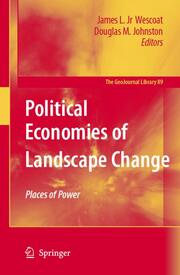Detailansicht
Political Economies of Landscape Change
Places of Integrative Power, GeoJournal Library 89
ISBN/EAN: 9789048174560
Umbreit-Nr.: 1788429
Sprache:
Englisch
Umfang: xvi, 222 S., 50 s/w Illustr.
Format in cm:
Einband:
kartoniertes Buch
Erschienen am 22.11.2010
Auflage: 1/2008
- Zusatztext
- InhaltsangabePreface and Acknowledgments,-Introduction: Three Faces of Power in LandscapeChange: James L Wescoat Jr.,- Part I. Landscapes of Struggle, Possibility, and Prosperity: 1: New Axioms for Reading the Landscape: Paying Attention to Political Economy and Social Justice: Don Mitchell,- 2: Landscapes of Possibility? Livelihood and Intervention in the Production of Andean Landscape: Anthony J. Bebbington,- 3. Moving to the Mountains: Amenity Migration in the Sierra and Southern Appalachian Mountains: Kurt Culbertson et al,- Part II. Political and Economic Driving Forces of Landscape Change,- 4: Constructing the Politics of Landscape Change in the U.S. Susan Clarke,- 5: Institutional Dynamics, Spatial Organization and Landscape Change: Tom Evans et al,- 6. Green Landscapes: Exogenous Economic Benefits of Environmental Improvement: Douglas M. Johnston and John B. Braden,- 7. Pricing the Economic Landscape: Global Financial Markets and the Communities and Institutions of Risk Management: Terry L. Babcock-Lumish and Gordon L. Clark,- Part III. Integrative Landscape Change,- 8. The Globalized Landscape: Rural Landscape Change and Policy in the United States and European Union: Joan Nassauer and Dirk Wascher,- 9. Implications for Landscape Inquiry, Planning, and Design: Douglas M. Johnston and James L. Wescoat Jr. ,- Contributors,- Index
- Kurztext
- "Places of Power" contributes to the Landscape Architecture Foundation's Landscape Futures Initiative, which explores driving forces of landscape change that societies and designers will face in the 21st century. Politics and economics exert profoundly important, and dynamic, influences on land use, landcover, and landscape experience. Likewise, landscapes shape political economies from the site to global scales. This book examines the complex relationships between political economy and landscape change. It encompasses perspectives ranging from radical landscape interpretation to sustainable livelihoods, real estate economics, institutions, international landscape policies, and global finance. It asks what difference "design", can make within the broader structural contexts of landscape change. The perspectives in this book share a common concern for what economist and futurist Kenneth Boulding termed "integrative power" - the power of human solidarity, respect, and love - to direct political and economic change toward paths of sustainable landscape design. They speak to landscape architects, planners, urbanists, geographers, and social scientists about some of the most pressing issues of our times.
